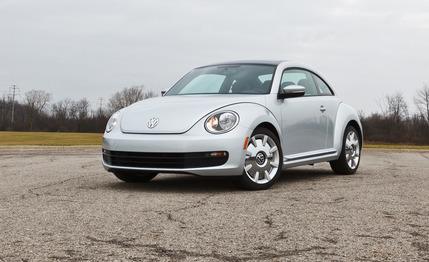 Instrumented Test
Instrumented Test

Longer, lower, wider. Those words were a Detroit marketing mantra in the 1950s, when the original Volkswagen Beetle began its march to immortality here in the U.S. But of course the thing that made the Bug so lovable, and such a counterculture icon, was that it possessed none of those traits.
Fast-forward to now: Here’s a Beetle that is, in fact, longer, lower, and wider than its predecessor. Specifically, 7.4 inches longer, 0.5 inch lower, and 3.3 inches wider. With the exception of height, those are some pretty big changes. And they produce a couple important results, one obvious, the other a little more subtle.
The obvious: The latest Beetle’s cuteness rating has dropped several notches, replaced by a corresponding increase in attitude.
The not-so-obvious: This second Beetle revival doesn’t depend on the nostalgia market. Introduced in 1998, the New Beetle pandered to a legion of baby boomers who nursed fond memories of the original. Most of them were women. A lot of them actually put flowers in the vestigial bud vases adorning their dashboards. Some named their cars “Herbie.”
That market—aging boomers—is no longer one that VW seeks to exploit. The target is younger buyers for whom the 1950s and ’60s are as relevant as the Crimean War. Thus, we have a sexier, more-contemporary-looking Beetle that should appeal to guys as well as girls.
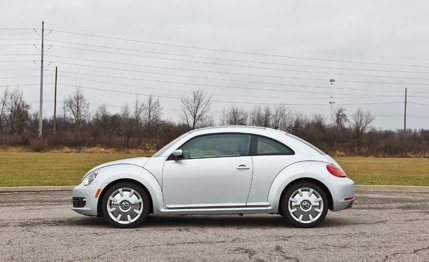
Depending, that is, on how it’s equipped. We think it’s fair to say that guys won’t be elbowing one another for a chance to drive the Beetle under scrutiny here.
Powertrain Proviso
The gen-three Beetle shares a lot of componentry with VW’s Golf and Jetta, including engines and transmissions. Our test subject’s 2.5-liter five-cylinder paired with the optional six-speed automatic is not a combination we equate with wheeled entertainment.
To be fair, VW has made a number of improvements to its unique inline-five since its installation in the previous Beetle. Horsepower and torque have both ramped up—20 ponies and 7 lb-ft—and NVH characteristics have been tailored to improve civility.
But the automatic, although smooth, is a definite performance killjoy. Our 0-to-60-mph run consumed 8.5 seconds, the quarter-mile, 16.5 at 85 mph. Very ho-hum, and the transmission’s manumatic function, accessed by wiggling the stick back and forth, improves neither giddyap nor joie de drive. For contrast, a 2.5-liter Golf three-door manual contending in our April 2010 comparison test hit 60 mph in 7.3 seconds and sprinted through the quarter-mile in 15.6 at 90.
Our advice: Go for the five-speed manual. VW of America advises that production of U.S. three-pedal versions began in late November—a little behind the automatics—so those models should be in showrooms as you read this.
The Athletic Index
Although the 2.5 with an automatic isn’t a combination likely to activate adrenal glands, the Beetle’s dynamics score as commendable. Like its compact relatives, the Golf and the Jetta, the Beetle’s body shell is structurally solid, with subframes supporting suspension elements at both ends of the car. In this iteration, there are struts up front and a torsion-beam axle at the rear; the suspension setup may seem minimalistic, but it delivers surprisingly decisive responses and, with the exception of its ride quality, compares very well with the more sophisticated multilink rear system in the Beetle Turbo. This is not to say that the ride is unpleasant—it’s just not quite as supple as the Turbo’s.
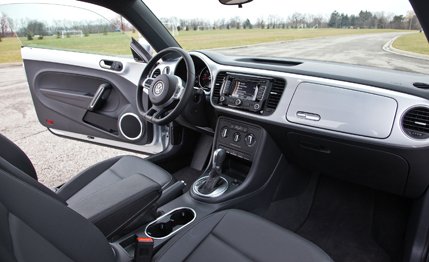
Skidpad grip, measured at 0.87 g, was delivered with the help of a set of 235/45-18 all-season Bridgestone Turanzas (part of our tester’s Sunroof, Sound, and Navigation package; the Turbo rolls on the same rubber). That number is respectable for a compact car with minimal sporting aspirations. It might have been even better if the stability control could be defeated, but it can’t. Test sheet notes suggest a reason for this: “No stability-off switch because the Germans think you are a bad driver.”
Braking is another performance element that could be improved—good pedal feel, so-so 70-to-0-mph stopping distance (176 feet). And the hydraulic-assist (as distinct from electric) rack-and-pinion steering could use more on-center feedback, although tactility improves when the driver puts in a little torque and gets even better in quick transitions.
The Inside Story
Because of its stretched-out proportions, the latest Beetle looks like it might not provide quite as much vertical space inside, but this is illusory. Remember, the car’s height diminished only a half-inch in the redesign, so front-seat headroom is abundant and rear headroom good for anyone up to about six-foot-three, even in Beetles equipped with a sunroof. The rear seats are readily accessible, thanks to the forward-folding function of the front seats and wide door openings. There’s also more room under the fastback rear hatch—15 cubic feet versus 12 in the previous Beetle—and as in any good hatchback, the rear seatbacks fold forward to expand capacity, in this case to 30 cubic feet.
The longer hood and the steeper windshield rake haven’t diminished the driver’s forward sightlines, nor have the higher beltline and the lower roof—key elements in the car’s cool chopped-top look—impaired vision in the rear quarters. And the standard tilting-and-telescoping steering column makes it easy to achieve an optimal relationship with the various controls.
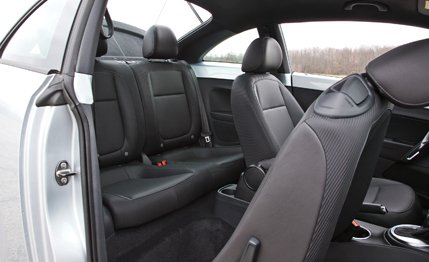
The interior design team maintained a retro look to the dashboard, with painted or (optional) faux carbon fiber rather than vinyl. Over and under glove boxes are also inspired by the original Beetle.
Retro doesn’t apply to the instrument panel, unless you count the absence of a coolant-temperature gauge. After all, the original Beetle also lacked this instrument. But then, it would have been a strange item in the original, which didn’t require coolant. But if retro doesn’t apply to the three-gauge (speedo, tach, fuel gauge) cluster, familiar certainly does, at least to anyone who’s been inside a recent Golf or Jetta. This also applies to the HVAC controls and center stack in general.
One other interior note: It’s quiet in there. When pressed, the Beetle’s five-cylinder emits an agreeable growl, but in most operating situations it’s subdued, and very little wind or road noise filters into the cabin.
Beetle Bucks
As we roll over the 2012 starting line, VW dealers have essentially two versions of the Beetle in their inventories—those using the 2.5-liter five and those propelled by the 200-hp, 2.0-liter turbo four. The 2.5-liter Beetle is available in three models: base 2.5L ($20,565); 2.5L with Sunroof ($23,065); and 2.5L with Sunroof, Sound, and Navigation ($24,865). All those prices are for manual-transmission models. If you want the autobox, add $1100 to the sticker. (VW’s six-speed dual-clutch automatic is limited to the Beetle Turbo, although we weren’t fans of that particular version of the transmission.) There are no major, free-standing options.
Base Beetle 2.5L equipment goes beyond basic. It includes air conditioning; an eight-speaker sound system with Bluetooth and iPod connectivity; a tilting-and-telescoping steering wheel; power windows; cruise control; halogen headlamps; a three-spoke leather steering wheel; leatherette seating surfaces; 17-inch aluminum wheels with 215/55 all-season tires; four-wheel disc brakes; and traction and stability control.
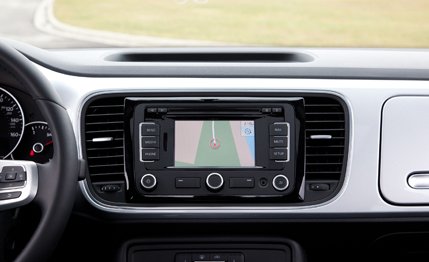
The Sunroof version includes Sirius satellite radio (not available on lesser trim levels); keyless access and pushbutton start; a center front armrest; premium audio with a six-CD changer and touchscreen controls; a multifunction leather-wrapped steering wheel; and, of course, a big power sunroof with tinted glass.
The 2.5L with Sunroof, Sound, and Navigation, our test subject, resides at the top of the model lineup, distinguished by the sunroof; the 18-inch wheel-and-tire package; a 400-watt Fender audio system; and a nav system.
Final Word
As if the case for the manual wasn’t strong enough, Beetles so equipped use less gas in highway cruising than automatic cars. Manual-transmission models are rated at 22 mpg in the city, 31 highway; automatics at 22/29. We averaged 20 mpg during our travels with the automatic 2.5.
But if mpg is really a priority, you may want to wait until the 2.0-liter turbo-diesel engine comes along, sometime toward the end of summer. No word on pricing for that one yet, but we’d anticipate something a little north of $24,000 with a manual transmission.
Finally, we note that the price tag of our loaded test car—$25,965—would be more than enough to put you into a Beetle Turbo: $24,165 with manual transmission, $25,265 with the DSG. If a quick bug is the priority, that arithmetic is hard to ignore.